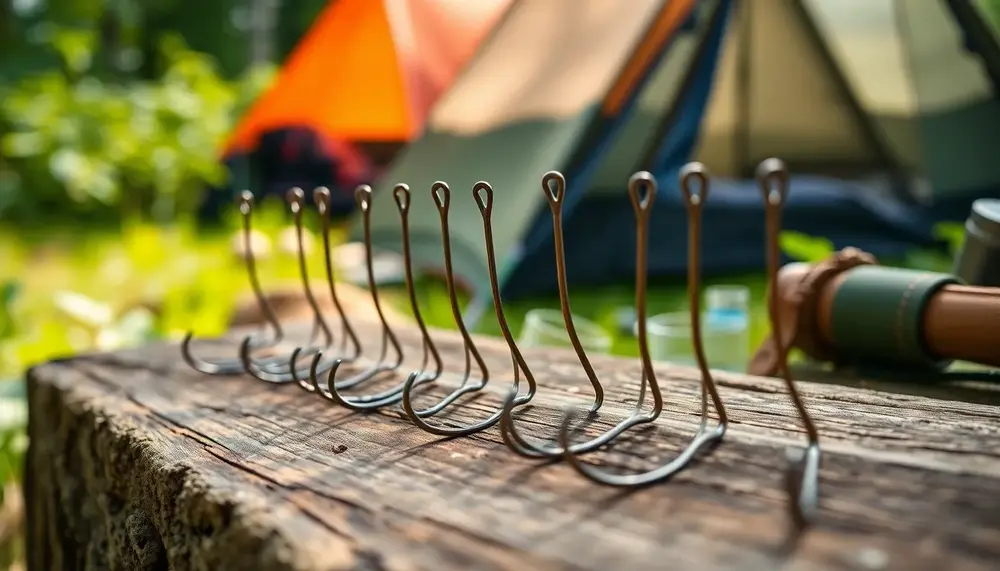Table of Contents:
Application Areas and Key Advantages of Sustainable Fish Hooks
When it comes to picking a sustainable fish hook for your next trip, you’re not just making a nod to the environment—you’re actively changing the way you fish. These hooks aren’t some niche gadget for eco-warriors; they’re built for practical use in real-world scenarios where both fish welfare and angler satisfaction matter. Let’s get right to the point: where do these hooks shine, and what’s in it for you?
- Reef and Sensitive Waters: Sustainable hooks are particularly suited for fishing in coral reefs, estuaries, and protected waters. In these areas, minimizing ecological disturbance is crucial. Using the right hook can mean the difference between a thriving habitat and one that’s quietly suffering.
- Catch-and-Release Hotspots: If you’re planning to release your catch, these hooks are engineered to reduce deep hooking and tissue damage. That’s not just good for the fish—it’s good for your conscience and the future of your favorite fishing spots.
- Multi-Species Versatility: Whether you’re after trout in a crystal-clear stream or chasing coastal predators, sustainable hooks offer reliable performance across a surprising range of species. You don’t have to compromise on your target list just to do the right thing.
- Compliance with Regulations: In many regions, especially in Europe and North America, using sustainable or barbless hooks is becoming a legal requirement in certain waters. Having the right hook in your tackle box keeps you on the right side of the law—no last-minute surprises at the water’s edge.
- Improved Fish Survival Rates: Thanks to innovative hook shapes and materials, these hooks dramatically increase post-release survival. That means more fish living to fight another day, and more sustainable fun for everyone.
In short, sustainable fish hooks aren’t just a feel-good choice—they’re a strategic upgrade for anglers who want to fish smarter, not harder. If you care about your impact, your catch rate, and the long-term health of your favorite waters, these hooks are already working in your favor.
Material Choices and Environmental Considerations
Choosing the right material for your sustainable fish hook is not just a technical detail—it’s a game-changer for both your fishing experience and the environment. Let’s be honest: the days of ignoring what your gear is made of are over. Now, it’s all about picking hooks that go the distance without leaving a mess behind.
- High-Strength, Corrosion-Resistant Metals: Modern sustainable hooks often use carbon steel or marine-grade alloys. These materials are tough enough to handle big fish, yet they’re designed to resist rust, meaning you won’t be tossing them after just a few trips. That’s less waste, plain and simple.
- Biodegradable and Plant-Based Packaging: Many top brands now ditch plastic for packaging made from renewable resources. Certified compostable materials—look for ASTM6400 or EN1343 standards—help ensure that your purchase doesn’t end up polluting the very waters you love.
- Minimalist Finishes and Coatings: Some hooks feature eco-friendly coatings that avoid heavy metals or toxic chemicals. This reduces the risk of leaching harmful substances into aquatic ecosystems, which is a win for everything from tiny invertebrates to trophy fish.
- Longevity Equals Less Waste: A well-made hook lasts longer, so you buy fewer replacements. That’s a small change with a big ripple effect—less manufacturing, less shipping, and less landfill clutter. It’s the kind of quiet sustainability that actually adds up.
Ultimately, your choice of hook material and packaging says a lot about your commitment to responsible angling. By opting for durable metals and compostable packaging, you’re not just following a trend—you’re setting a new standard for what it means to fish sustainably.
Innovative Hook Designs for Fish Welfare
Innovative hook designs are quietly transforming how anglers interact with fish, especially when it comes to welfare and survival. Forget the old-school approach—today’s hooks are engineered with the fish’s well-being at the forefront, using clever tweaks that make a real difference once you’re on the water.
- Circle Hooks: Their rounded profile is more than just a visual quirk. These hooks are designed to slide out of the throat and catch securely in the corner of the fish’s mouth, drastically reducing internal injuries. This simple change means a much higher chance the fish will swim away healthy.
- Barbless Innovations: Modern barbless hooks aren’t just regular hooks with the barb pinched off. Some feature micro-grooves or textured surfaces to help hold the fish during the fight, yet they release easily with minimal force. That’s less stress for the fish and a smoother experience for you.
- Bite-Shortened Hooks: These modified hooks have a shortened shank, making it easier to unhook fish without handling them or removing them from the water. Studies1 show this design can significantly reduce post-release mortality, especially for sensitive species.
- Quick-Release Mechanisms: Some cutting-edge designs now incorporate quick-release systems, allowing anglers to unhook fish directly in the water with a single-handed motion. This innovation is a real game-changer for catch-and-release, minimizing air exposure and physical contact.
Every one of these design choices is a step toward more ethical fishing. They’re not just clever—they’re proven to help fish recover and thrive after release, letting you enjoy your sport with a lighter conscience and a bigger smile.
1 Reference: T. R. Reichers et al., “Catch-and-release mortality of spotted seatrout using modified barbless hooks,” North American Journal of Fisheries Management, 2022.
Choosing the Right Hook Size and Customization Options
Finding the ideal hook size is more than a matter of matching numbers on a package—it’s about maximizing efficiency and minimizing harm for each species and scenario. If you’re after small, delicate fish, a smaller hook reduces unnecessary injury. For larger, robust species, a bigger hook ensures secure holding without excessive penetration. The right size means less struggle, faster releases, and healthier fish populations in the long run.
- Species-Specific Sizing: Manufacturers now offer sustainable hooks in a wide spectrum of sizes, often tailored to regional target species. This lets you fine-tune your approach, whether you’re after panfish, bass, or coastal giants.
- Method-Based Selection: Some hook sizes are optimized for specific techniques—think drop-shotting, live baiting, or fly fishing. Picking the right size for your method can dramatically improve your hookup and release rates.
- Customization at Home: For anglers who want even more control, certain sustainable hook types—like bite-shortened or custom barbless hooks—can be crafted from standard hooks using simple tools. Online guides and videos make DIY customization surprisingly accessible, letting you adapt your gear to local regulations or personal ethics.
- Color and Finish Options: While not strictly about size, modern sustainable hooks sometimes offer non-reflective or camouflaged finishes. These options help reduce fish spooking and can be selected to match water clarity or light conditions, giving you a subtle edge.
Ultimately, choosing the right hook size and exploring customization isn’t just about following best practices—it’s about actively shaping your fishing experience to be both effective and ethical. A little attention to detail here can make a world of difference on the water.
Recent Studies and Case Examples: Sustainable Hooks in Action
Recent research is shedding light on how sustainable hooks are performing in real-world angling. Instead of relying on theory, scientists and fisheries managers are putting these designs to the test—sometimes with surprising results.
- Field Trials with Modified Hooks: In a controlled study on spotted seatrout, researchers compared standard barbed hooks, traditional barbless models, and innovative bite-shortened hooks. The bite-shortened version enabled anglers to release fish directly in the water, significantly reducing handling time and air exposure. Post-release survival rates jumped, especially in warmer months when fish are most vulnerable1.
- Regulatory Success Stories: Several protected areas in North America and Europe have mandated the use of barbless or circle hooks. Follow-up monitoring found a measurable increase in fish survival and a decrease in accidental bycatch injuries. These results have encouraged broader adoption of sustainable hook regulations among conservation-minded fisheries.
- DIY Hook Adaptation: Anglers in online communities are sharing guides for modifying off-the-shelf hooks into more sustainable forms—such as removing barbs or shortening shanks. Reports from these grassroots efforts highlight not only improved fish welfare but also a sense of empowerment and stewardship among participants.
- Commercial Charter Feedback: Guides running catch-and-release charters report fewer lost fish and less gear waste when using high-quality sustainable hooks. Their clients appreciate the visible commitment to conservation, and many return specifically for the ethical fishing experience.
1 Source: T. R. Reichers et al., “Catch-and-release mortality of spotted seatrout using modified barbless hooks,” North American Journal of Fisheries Management, 2022.
Conclusion: Making a Responsible Choice for Your Next Fishing Trip
Making a responsible choice for your next fishing trip means considering not just what you catch, but how your actions ripple through the ecosystem. Sustainable hooks are a small but powerful tool in your kit—yet the bigger picture is about your overall approach to angling.
- Stay Informed: Keep up with evolving local regulations and scientific findings. Fisheries management is dynamic, and new best practices can emerge quickly. Being proactive ensures your methods remain both legal and effective.
- Share Knowledge: Encourage fellow anglers to adopt sustainable gear and techniques. Word-of-mouth and demonstration are often more persuasive than any rulebook, and your influence can multiply positive change.
- Monitor Your Impact: Take note of fish condition after release, and adjust your approach if you observe signs of stress or injury. Responsible anglers are always learning and adapting.
- Support Ethical Brands: Choose products from companies that invest in research, transparency, and eco-friendly manufacturing. Your purchasing decisions drive industry standards forward.
Ultimately, responsible fishing is about respect—for the resource, for future generations, and for the living creatures you encounter. With thoughtful choices and a willingness to adapt, you can enjoy your passion while helping to safeguard the waters you love.
FAQ on Sustainable Fish Hooks for Responsible Angling
What makes a fish hook sustainable?
A sustainable fish hook is designed to minimize environmental impact and fish injury. Key features include eco-friendly materials (like carbon steel), durable construction to reduce waste, plastic-free or compostable packaging, and specialized shapes such as circle or barbless designs that promote fish survival after release.
Why should I use sustainable hooks when practicing catch-and-release fishing?
Sustainable hooks help reduce deep hooking and tissue damage, making it easier to release fish unharmed. This increases post-release survival rates and supports the conservation of fish populations, ensuring healthier waters and better fishing opportunities in the future.
What types of sustainable hook designs are available?
Popular sustainable hook designs include circle hooks, barbless hooks, and bite-shortened hooks. Each is engineered to minimize injury, secure hookups in the corner of the mouth, and facilitate quick, gentle releases. Some innovative models even feature quick-release mechanisms to further reduce fish handling.
Are sustainable hooks suitable for different species and fishing methods?
Yes, sustainable hooks come in a range of sizes and shapes to suit various species, from trout to coastal game fish. They are also offered for specific techniques like fly fishing or live baiting. Some designs can even be customized at home to fit your preferred style and local regulations.
How do I properly choose the right sustainable hook for my trip?
Consider the species you’re targeting, your fishing method, regional regulations, and the specific waterbody. Opt for durable, corrosion-resistant hooks in an appropriate size. Prioritize barbless or circle designs for catch-and-release, and look for brands using eco-friendly packaging. Staying informed and adapting your gear is key to responsible and effective angling.







